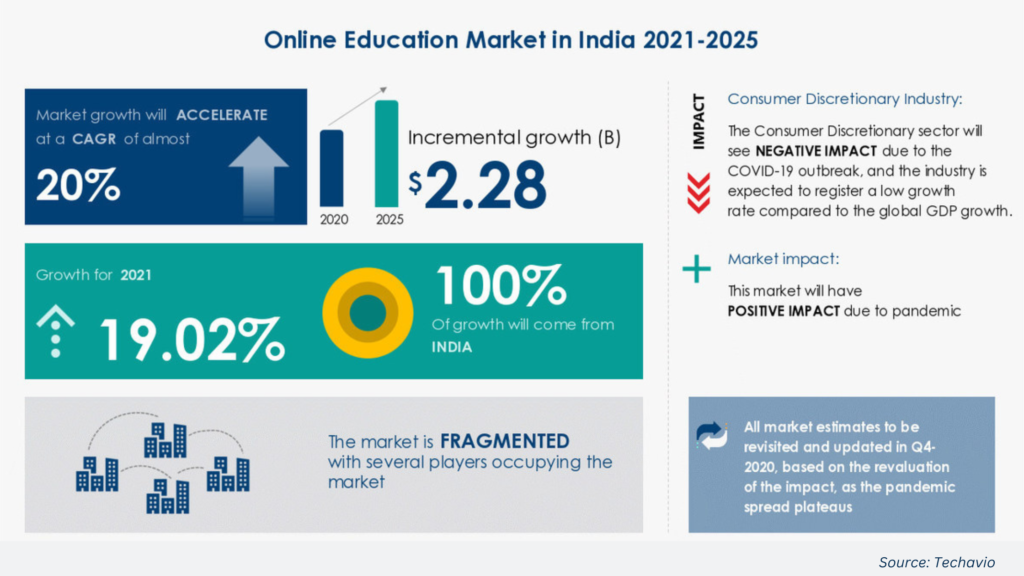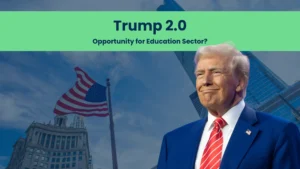India, with its staggering population exceeding 1.3 billion, harbors the world’s largest cohort of individuals aged between 5 and 24 years, totaling a staggering 580 million. This demographic powerhouse translates into an expansive market for the education sector, boasting over 250 million school-going students. Projections from the India Brand Equity Foundation (IBEF) estimate that by the fiscal year 2024-25, India’s education market could reach an impressive US$ 225 billion.
Moreover, India’s proficiency in English, ranking 48th out of 112 countries on the English Proficiency Index in 2021, facilitates seamless delivery of educational products, including online programs. The government’s allowance of 100 percent foreign direct investment (FDI) in the education sector, coupled with proposed regulatory reforms like the establishment of the Higher Education Commission of India (HECI) outlined in the National Education Policy 2020, underscores the nation’s commitment to fostering a conducive environment for educational development. According to Statista estimates, the Indian Edtech industry is valued at US$2.8 billion and expected to reach US$10.4 billion by 2025. There are about 9,043 EdTech startups in India.
With over 255 million youth aged between 15 and 25, and a target to elevate the gross enrollment ratio (GER) from 27 percent to 50 percent by 2030, India’s urgent need for quality education infrastructure and resources is palpable. The government’s forthcoming guidelines aimed at facilitating the entry of foreign players into the education sector further underscore the opportunities awaiting investors seeking to tap into India’s burgeoning education market.
Amidst this landscape of demographic dividends, regulatory reforms, and governmental initiatives, the Indian education sector emerges as a beacon of opportunity for investors eager to partake in the nation’s educational transformation. In this blog, we delve into the statistical data and insights that define this dynamic market, unveiling the myriad investment opportunities that await those ready to capitalize on India’s educational evolution.
Trends in the Education System of India
Rise of EdTech:
The Indian EdTech sector has experienced unprecedented growth, with a Compound Annual Growth Rate (CAGR) of 52% between 2016 and 2021 (Source: RedSeer Consulting). This surge can be attributed to factors such as increasing internet penetration, smartphone usage, and digital literacy among students.
Demand for Vocational Education:
According to a report by the National Skill Development Corporation (NSDC), India is projected to require 700 million skilled workers by 2025 across various sectors. This has led to a growing emphasis on vocational education and skill development programs to meet the needs of the rapidly evolving job market.
Adoption of Online Learning:
The COVID-19 pandemic accelerated the adoption of online learning in India, with a significant shift towards virtual classrooms, e-learning platforms, and digital content delivery. As per a survey by Omidyar Network India and RedSeer, the online K-12 market in India is expected to reach $1.7 billion by 2022.
Government Initiatives:
The Indian government’s initiatives such as the National Education Policy (NEP) 2020 and Skill India Mission aim to transform the education landscape by promoting holistic development, digital literacy, and vocational training. These initiatives provide a conducive environment for businesses to innovate and thrive.

Opportunities for Business Expansion in India
Large English-speaking Population:
India now claims to be the world’s second-largest English-speaking country. The most reliable estimate is around 10% of its population or 135 million people, second only to the US and expected to quadruple in the next decade, presenting a significant advantage for businesses looking to deliver educational products and services. This linguistic advantage facilitates seamless communication and accessibility, enhancing the reach and impact of educational initiatives across the country.
Strong Technology Infrastructure:
India boasts a robust technology infrastructure, characterized by high-speed internet connectivity and widespread smartphone usage, with over 820 million internet users, making it the second-largest internet user market globally. This technological ecosystem creates a conducive environment for the adoption of technology-driven educational solutions, such as online learning platforms, virtual classrooms, and interactive learning apps.
Favorable Government Policies:
The Indian government has implemented several favorable policies aimed at transforming the education system to meet the needs of the 21st century. Initiatives such as The National Education Policy (NEP) 2020, Sarva Shiksha Abhiyaan, and Rashtriya Ucchatar Shiksha Abhiyan provide a framework for innovation and reform in the education sector, offering opportunities for businesses to collaborate and contribute to educational development.
Improving Higher Education Ecosystem:
Recent developments, including the University Grants Commission of India’s (UGC) approval of regulations for foreign collaboration to offer joint, dual, or twinning programs, and the announcement of Draft Regulations 2023 to allow foreign universities to establish physical campuses in India, signal a significant shift in the higher education ecosystem. These initiatives open doors for international partnerships and collaborations, fostering innovation and diversity in India’s higher education landscape.
IFSC GIFT City:
The International Financial Services Centre (IFSC) at Gujarat International Finance Tec-City (GIFT City) provides a unique opportunity for foreign universities to set up offshore centers in India. This initiative aims to promote global collaboration and knowledge exchange in education, offering a strategic gateway for foreign universities to establish their presence in the Indian market.

India to become globally prominent education hub:
- India to become $313 Bn education market by 2030.
- Indian Education System is one of the largest in the world with more than 1.46 Mn schools and 230 Mn students participating in modern K-12 education.
- Edtech startups raised more than $2.2 Bn in 2020.
Conclusion:
As we conclude our exploration of the thriving landscape of education investment in India, it’s clear that the opportunities abound, offering immense potential for investors. The projected surge of USD 2.28 billion in the online education sector from 2021 to 2025 underscores the significance of tapping into India’s educational market.
Education stands not only as a means of reducing poverty and inequality but also as a cornerstone of enhancing India’s global competitiveness. With the sector expected to reach a monumental value of USD 225 billion by 2025, investing in educational projects in India presents not just a financially rewarding venture, but also an avenue to contribute to shaping a brighter future for millions of learners.
The substantial commitment reflected in the unprecedented allocation of US$ 13.66 billion in the Union Budget 23-24 underscores the government’s dedication to fostering educational excellence. Complemented by the visionary New National Education Policy launched in 2020, India is poised to emerge as a global knowledge powerhouse, offering unparalleled opportunities for investors.
Looking ahead, India’s education and skills market is primed for exponential growth, projected to double to US$ 313 billion by 2030. This growth trajectory, coupled with the demographic advantage of a youthful population exceeding 580 million, solidifies India’s position as a premier destination for education investment.
As India continues to witness the rise of middle-income and high-income households, driving demand and growth in the education sector, investors have a unique opportunity to contribute to the nation’s educational advancement while reaping substantial returns on their investments.
Navigating the intricacies of the Indian Education Market requires expertise and tailored strategies. By partnering with seasoned professionals like India Market Entry ( IME), investors can leverage specialized insights and strategies to penetrate the market effectively and achieve success expediently. With its burgeoning youth population and forward-thinking policies, India’s education sector offers a transformative journey for investors, shaping the future of education and workforce development in the world’s largest democracy.
Sources:
https://www.india-briefing.com
https://www.investindia.gov.in
https://www.ibef.org/industry/education-sector-india
https://www.statista.com/outlook/emo/online-education/india
https://www.nielsen.com/insights





